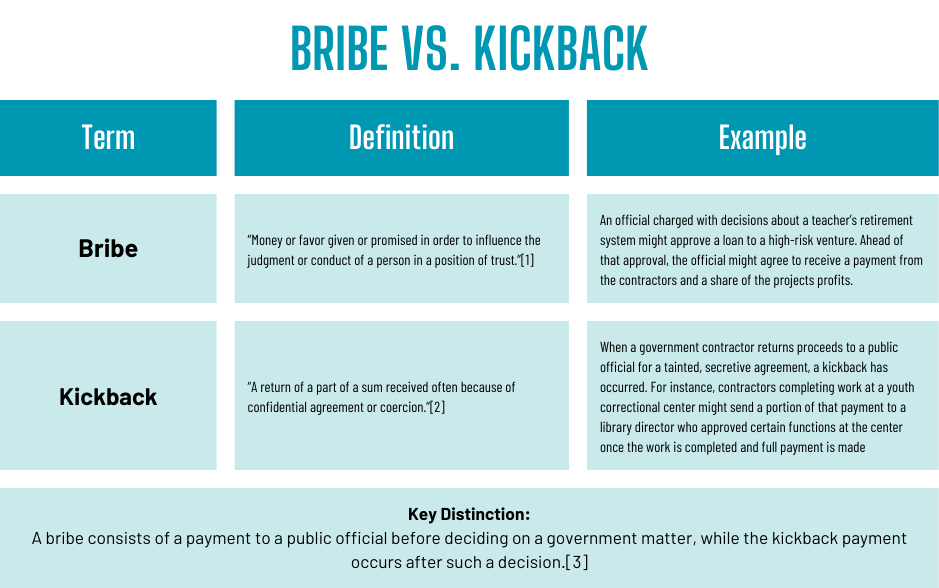A core goal of a high-functioning procurement office is that it maintains robust ethical standards. Such standards ensure trust from the public and avoid even appearances of impropriety. Failure to adhere to these standards can place the integrity of the office and the officials who work there at risk. It also undermines competition as a core tenet of public procurement.
Two unethical behaviors are “bribes” and “kickbacks.” These terms are often used interchangeably in everyday discussions, media reports, and fictional dramas. But knowing the differences between them can promote a more ethical and less wasteful procurement landscape:

Best Avoidance Practices
Kickbacks and bribes are statutorily prohibited in 36 states. Some states also prohibit unethical practices in standard contract terms. Most states have regulations, statutes, or standard contract terms that impose sanctions for actions such as bribes and kickbacks.[1]
Daniel Glad, director of the U.S. Department of Justice Procurement Collusion Strike Force, said on an episode of the NASPO Pulse Podcast that pattern recognition is the key to spotting potential bribery or kickback schemes. For example, if an honest actor working in a procurement office prepares to open a bid package and has a gut feeling — regardless of the merits of the bid — about whom their supervisor has selected, that could be a sign that the procurement official is sensing a pattern. Such patterns may appear in bid awards, pricing that doesn’t correspond with markets, and collusion clues, such as identical typos in two different letters. Investing in data analytics can be a valuable tool in this detection.[2]
“Does it all even out, or is there a clear pattern of rotation?” Glad poses. “I think there’s an assumption that they can get away with it and hide in plain sight.”[3]
While the “vast, vast, vast majority of government employees at all levels are doing the right thing the right way for the right reason,” Glad advises being alert.[4]
Legal Specifics
Legal definitions can make the process of prosecuting bribes and kickbacks complex. For example:
- Under Federal law, the briber does not necessarily need to “spell out which payments control which particular official acts.”[5] Instead, prosecutors must prove a “stream of benefits” that correlates with official acts.[6]
- Federal law also does not require the two parties to come to a specific agreement. A briber may be convicted even if the bribe is not accepted.[7] The party who receives the bribe or kickback may be convicted even if the payor did not intend to commit a crime.[8] Ambiguity exists over whether a bribe may be prosecuted when the official accepts a bribe but doesn’t follow through on the payor’s wishes.[9]
Glad advises reporting any suspicious activity, even if the person reporting it is unclear whether a crime is being committed or the facts do not fully add up yet to a chargeable case. [10]
Suspicions, as well as training requests, can be sent via email to pcsf@usdoj.gov. [11]
Top-notch procurement offices prioritize maintaining ethical standards. This includes knowing the intricacies of bribes and kickbacks. Distinguishing the two can help procurement officials prevent them from happening in their office. If and when it does occur, those officials will be better prepared to spot and report it.
[1] NASPO, “Fact Sheet: Procurement Ethical Practices and Principles,” last modified October 2019.
[2] Kevin Minor and Megan Smyth, hosts, “Part I Use the Strike Force with Daniel Glad,” NASPO Pulse Podcast, May 23, 2023, 34 minutes, https://pulse.naspo.org/post/part-i-use-the-strike-force-with-daniel-glad/.
[3] Minor and Smith, “Part I Use the Strike Force,” NASPO Pulse Blog.
[4] Minor and Smith, “Part I Use the Strike Force,” NASPO Pulse Blog.
[5] United States v. Terry, 707 F.3d 607, 612 (6th Cir. 2013) (collecting cases)
[6] Ibid.; United States v. Bahel, 662 F.3d 610, 635 (2d Cir. 2011); United States v. Bryant, 655 F.3d 232, 241 (3d Cir. 2011); United States v. Silver, 184 F. Supp. 3d 33, 43 (S.D.N.Y 2016).
[7] United States v. Ring, 706 F.3d 460, 467 (D.C. Cir. 2013)
[8] United States v. Morgan, 635 F. App’x 423, 431 (10th Cir. 2015).
[9] United States v. Nagin, 810 F.3d 348, 351 (5th Cir. 2016)
[10] Minor and Smith, “Part I Use the Strike Force,” NASPO Pulse Blog.
[11] Minor and Smith, “Part I Use the Strike Force,” NASPO Pulse Blog.

